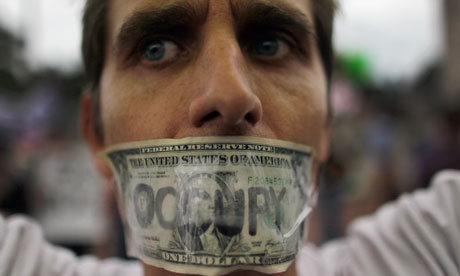It's official: wealth inequality accelerated over the past quarter century. The American dream was never a more hollow promise
Richard Wolffguardian.co.uk, Wednesday 26 October 2011 18.13 EDT
 A demonstrator tapes a dollar bill over his mouth in the Occupy Miami protest. Photograph: Joe Raedle/Getty Images
A demonstrator tapes a dollar bill over his mouth in the Occupy Miami protest. Photograph: Joe Raedle/Getty Images The just-released
Congressional Budget Office report, Trends in the Distribution of Household Income Between 1979 and 2007, supports a basic claim of the
Occupy Wall Street (OWS) movement sweeping the country: that deep economic inequality is corrupting politics, culture and American society as a whole.
CBO reports are almost universally considered and relied upon as epitomes of non-partisan research. Simply put, the CBO report shows that over the last quarter century (1979 to 2007, to be exact),
the top 1% of income earners enjoyed far, far bigger real income gains than the other 99%. As a result, the share of total income earned by the top 1% rose dramatically – doubling from 10% to 20% – at the expense of falling shares of income for all of the other 99% of the US population.
No wonder the OWS movement showed genius in crafting and adopting the slogan "We are the 99%."
No wonder polls already show a majority of Americans expressing sympathy with the OWS movement barely five weeks after it was born – a stunning achievement relative to comparable mass movements in US history.
The CBO numbers teach some basic lessons. First, the last 30 years of ideological preaching about the superiority of private, deregulated, market-driven capitalism served to enable and mask one of the largest and fastest
upward redistributions of income in modern history. The gap between the tiny rich minority and everyone else widened dramatically. The CBO report thus documents
the actual class war over recent decades: the real winners and losers. The report thereby exposes the absurdity of the recent bleats from the 1% denouncing modest efforts to limit their huge gains as – horror of horrors – "class war".
Second, the CBO report shows that the US government's transfer payments (social welfare supports for the poor, social security and Medicare spending, and so on) did not offset the upward redistribution of income to the richest 1%. Nor did the federal tax structure. The 1% used its growing wealth to make government taxing and spending policies aid, rather than constrain, the class war they pursued so systematically. The CBO report concludes that the top 1% was the only portion of the total income-earning US population to experience a sharp rise in its share of the total US income
taking into account all federal transfers and taxes. Indeed, the top 1%'s share of income rose further after all transfers and taxes are taken into account than before taking them into account. Federal spending and taxing policies were thus complicit in furthering this last generation's sharp turn toward greater income inequality.
Third, the CBO report documents that alongside the staggering fact and impact of the current economic crisis – the second major collapse of capitalism in the last 75 years – there was the preceding and equally staggering fact of massive upward redistribution of income. How are these two facts related? The answer is not difficult to discern.
The 99% were falling ever further behind the top 1%. The latter's exploding luxury consumption shaped tastes and standards defining the "American dream." With real wages stagnant in the US since the 1970s, the 99% tried to reach or keep the dream by sending more family members out to work more hours, and borrowing ever larger amounts, over the last 25 years. Eventually, their exhaustion and stress from increased work, coupled with unsustainable levels of accumulated household debt (for homes, college expenses, automobiles and credit cards), brought the economy to the brink of crisis.
Meanwhile, the speculative excesses of the 1% who were enjoying unprecedented income and wealth gains took the
US economy over the brink. Such consequences of a falling share of the national income for 99% of the US population were key contributors to the current crisis – and are key contributors to its depth and duration. In sum, the last generation's upward redistribution of income helped to cause the current global capitalist meltdown.
To fully appreciate the social impact of the fast-deepening income inequality, it needs to be seen alongside the equally fast-deepening wealth inequality in the US. If citizens here possess any appreciable wealth, it takes the form of their homes. US housing prices have fallen through the crisis (since 2007). Over the same time, the rising use of home equity as collateral for loans has cut the portion of home values owned by occupiers, while raising the portion owed to banks. The combination of falling home prices and falling owners' equity in those homes yields another massive upward redistribution of wealth. That is because stock markets "recovered" – thanks to massive infusions of government money into financial institutions. Wealth in the form of stocks and bonds thus rose relative to wealth in the form of home ownership. Stock and bond ownership is highly concentrated in the US, much more so than home values. The result is deepening inequality of wealth distribution alongside greater income inequality.
The claims and promises of US capitalism to be an engine that builds and sustains a vast "middle class" and that constantly "delivers the goods" seem more hollow today than ever. Questions, criticisms and opposition bubble up across the country. The CBO report reflects, as well as documents, the underlying economic realities. However inadvertently, it thereby supports the rising tide of
protest.


No comments:
Post a Comment